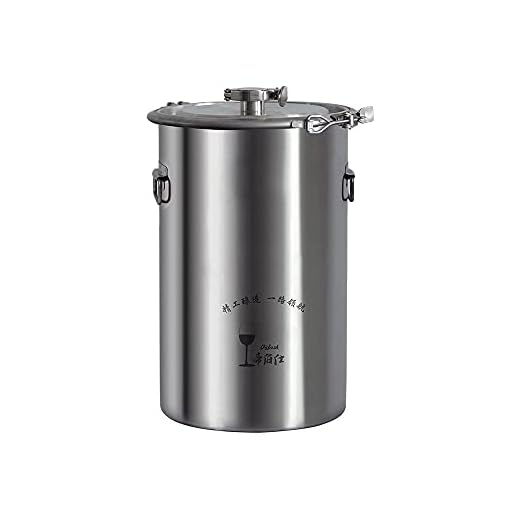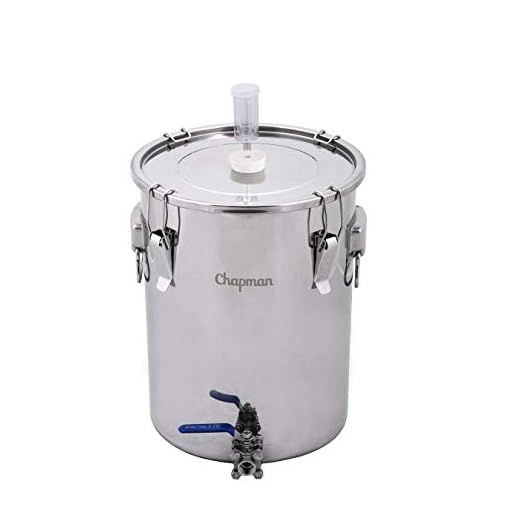



Fermentation relies on various microorganisms, notably fungi, to transform sugars into alcohol and carbon dioxide. In the case of fermented grape juice, these fungi play a pivotal role in the overall flavor profile and character of the beverage. The presence of these organisms can significantly influence the taste, aroma, and texture of the final product.
During the fermentation process, natural fungi are often present on grape skins, contributing to spontaneous fermentation. This method can yield complex and unique flavors, reflecting the terroir of the vineyard. If you’re curious about exploring diverse flavor profiles, look for options that utilize natural fermentation methods instead of those relying solely on commercial strains.
For those interested in home production, using wild fungi can be an exciting adventure. Ensure that the grapes are sourced from organic vineyards, as this increases the likelihood of beneficial microorganisms being present. Following good sanitation practices will also help maintain a healthy fermentation environment.
Yeast Presence in Red Varietals
Yes, fermented grape beverages are produced using yeast. This microorganism plays a crucial role in transforming sugars found in grapes into alcohol and carbon dioxide through fermentation. Without yeast, the fermentation process would not occur, resulting in a lack of alcoholic content.
Types of Yeast Used
Typically, winemakers utilize two main categories of yeast: wild and cultivated. Wild yeast, naturally present on grape skins and in the environment, can impart unique flavors and complexities. Cultivated strains, on the other hand, are selected for their reliability and specific fermentation characteristics, ensuring a consistent final product.
Impact on Flavor Profile
The choice of yeast significantly influences the aromatic and flavor profile of the finished product. Different yeast strains can enhance fruity, floral, or spicy notes, contributing to the overall tasting experience. Understanding this aspect can greatly enhance your appreciation of various styles and selections.
Understanding the Role of Yeast in Red Wine Fermentation
During fermentation, microorganisms play a pivotal role in transforming grape juice into an alcoholic beverage. The fermentation process is primarily driven by these tiny organisms, which convert sugars into alcohol and carbon dioxide.
Types of Microorganisms
- Saccharomyces cerevisiae: The most commonly used species, known for its efficiency and reliability.
- Wild yeasts: Naturally occurring in vineyards, they can impart unique flavors but introduce variability.
Fermentation Process
The initial step involves crushing the grapes, releasing their juice. This juice is then exposed to the selected microorganisms, which begin consuming the sugars. The process can take several days to weeks, depending on temperature and conditions.
Temperature control is crucial. Cooler temperatures slow down fermentation, while warmer temperatures can lead to faster fermentation but may result in undesirable flavors. Monitoring these conditions ensures the development of the desired profile.
Malolactic fermentation often follows the primary process. This secondary fermentation, typically facilitated by lactic acid bacteria, softens acidity and enhances complexity. This stage is particularly valued for adding buttery and creamy notes to the final product.
In conclusion, understanding the specific roles and behaviors of these microorganisms during fermentation is essential for crafting high-quality beverages. This knowledge allows for better control over flavor profiles and overall quality, leading to a more enjoyable tasting experience.
Types of Yeast Used in Red Wine Production
For optimal fermentation, the selection of microbial strains plays a critical role. Often, winemakers utilize Saccharomyces cerevisiae, known for its reliable fermentation capabilities and ability to tolerate high alcohol levels. This species efficiently converts sugars into alcohol and carbon dioxide, contributing to the overall flavor profile.
In addition to the conventional strains, some producers experiment with non-Saccharomyces yeasts, such as Brettanomyces. While this yeast can introduce unique, sometimes controversial characteristics, it can also enhance complexity and depth when used judiciously.
Another interesting option is wild fermentation, where indigenous microorganisms present on grape skins and in the winery environment initiate the process. This method can yield distinctive and terroir-driven expressions, but it also introduces variability that may challenge consistency.
Additionally, some winemakers opt for selected yeast strains that are tailored to specific varietals or desired flavor outcomes. These customized options can enhance aromatic profiles, promote malolactic fermentation, and improve mouthfeel, ultimately impacting the final product’s character.
Exploring different yeast applications enables a diverse array of taste experiences. Each choice influences the ultimate expression of the grapes, making it essential for producers to align their yeast selection with their stylistic goals.
How Yeast Affects the Flavor Profile of Red Wine
The choice of microorganisms during fermentation significantly influences the taste and aroma characteristics of the final product. Different strains contribute unique compounds, shaping the overall profile.
Impact on Aromatic Compounds
Microbes produce various volatile compounds, such as esters and phenols, that enhance the bouquet. For instance, certain strains can create fruity notes, reminiscent of berries or cherries, while others may impart floral or spicy undertones. This complexity adds depth and layers, enriching the sensory experience.
Fermentation Temperature and Its Influence
The fermentation temperature plays a pivotal role in flavor development. Higher temperatures often lead to increased ester production, yielding more pronounced fruity aromas. Conversely, cooler fermentation can preserve more delicate floral notes and maintain acidity, resulting in a balanced, elegant profile. Understanding this relationship allows vintners to tailor the outcome according to desired styles.
Ultimately, the selection and management of microbial activity are critical in crafting a distinct and memorable vintage. Each choice, from strain selection to temperature control, shapes the experience from the first sip to the last lingering note.
Natural vs. Cultured Yeast: What’s the Difference?
Choosing between natural and cultured microorganisms can significantly influence the character of your beverage. Natural strains, often referred to as wild, thrive in the vineyard environment, capturing the unique terroir. These organisms contribute to complex flavors and aromas, reflecting the specific conditions of the harvest year and locale.
On the other hand, cultured microorganisms are cultivated in controlled settings and introduced during fermentation. This method ensures consistency and reliability, allowing winemakers to achieve desired flavor profiles and fermentation rates. These strains are often selected for their predictable performance, making them popular among producers aiming for a specific style.
In practice, the choice between these two methods often depends on the desired outcome. Natural strains may lead to more varied and unpredictable results, which some connoisseurs appreciate for their uniqueness. Cultured varieties, while perhaps less adventurous, provide a framework for crafting high-quality beverages with a consistent identity.
Ultimately, understanding the distinctions between these types can enhance appreciation for the craftsmanship involved in the production process. When sampling different offerings, consider how the choice of microorganism may shape the overall experience, from aroma to taste.
The Impact of Yeast on Aging Processes
During the maturation phase, the presence of microorganisms plays a significant role in shaping the characteristics of the beverage. The interaction between these organisms and the liquid contributes to a complex flavor development, enhancing both aroma and taste.
As time passes, the activity of these microorganisms leads to the formation of various compounds that influence the sensory profile. This includes the creation of esters and phenolics, which can add depth and layers to the overall experience.
Factors such as temperature and humidity in storage conditions directly impact the efficacy of these microorganisms. Maintaining optimal conditions can enhance the maturation process, allowing for a more refined and integrated flavor profile.
Furthermore, the decision to use certain strains of microorganisms can dictate the pace and direction of aging. Selecting specific varieties known for their desirable traits can lead to distinct outcomes, influencing not only taste but also mouthfeel and body.
In summary, understanding the role of microorganisms during maturation is key for anyone looking to appreciate the intricacies of flavor evolution. It’s a journey that reflects both tradition and innovation in production techniques.
| Factor | Impact on Aging |
|---|---|
| Temperature | Affects metabolic activity of microorganisms, influencing flavor development. |
| Humidity | Impacts evaporation rates and concentration of flavors. |
| Microorganism Strain | Determines the nature and complexity of flavor compounds formed. |
Identifying Yeast Residues in Bottled Red Wine
To detect the presence of fermentation organisms in bottled beverages, a few straightforward methods can be employed. Start by observing the sediment at the bottom of the bottle. A light swirl can help reveal any deposits that may indicate remnants from the fermentation process.
Next, examine the clarity of the liquid. A cloudy appearance may suggest the presence of microbial activity, including fermentation by-products. If you notice a haze, consider decanting the liquid to separate it from any potential particulates.
Another effective approach involves pouring a small amount into a glass and inspecting it under good lighting. Look for tiny bubbles or foamy textures, which are indicators of carbon dioxide release associated with ongoing fermentation.
Using a microscope can provide a more precise analysis. Collecting a small sample and observing it can reveal the presence of individual organisms. However, this method requires specialized equipment and knowledge.
For those interested in deeper exploration, employing a testing kit designed for home brewers can yield quantitative results regarding microbial populations. These kits often assess sugar content and other fermentation indicators.
If you encounter bottled beverages that show signs of fermentation residues, consider reaching out to the producer for more information. They may offer insights into their production techniques and any variations that may have occurred.
Lastly, for a practical tip, if you’re dealing with equipment like a pressure washer, you might find it useful to read about how to change Lidl Parkside pressure washer nozzle. Understanding maintenance in different contexts can enhance your overall experience.
Best Practices for Home Winemakers Regarding Yeast
Choose a suitable strain based on the characteristics you desire for your creation. Research the specific attributes of various fermenting organisms to determine which will complement your grape varietals and climate conditions.
Sanitation is Key
Maintain a sterile environment. Clean all equipment thoroughly before and after use to prevent contamination. Use sanitizers designed for winemaking to ensure that your tools and containers are free from unwanted microorganisms.
Monitor Fermentation Temperature
Keep a close eye on the temperature during fermentation. Most fermenting organisms thrive within a specific range, typically between 65°F and 75°F. Too high or too low a temperature can lead to undesirable flavors or stuck fermentation.
Consider rehydrating dry strains before adding them to your must. This practice can help reactivate dormant cells and promote a more vigorous fermentation process, enhancing the overall quality of your final product.
Regularly check specific gravity to track sugar conversion. This will help you know when fermentation is nearing completion, allowing you to make informed decisions about next steps, such as racking or adding sulfites.
Finally, keep detailed notes throughout the process. Documenting your actions and observations will help refine your techniques and improve future batches. Each creation is a learning opportunity that can lead to remarkable discoveries in flavor and style.










